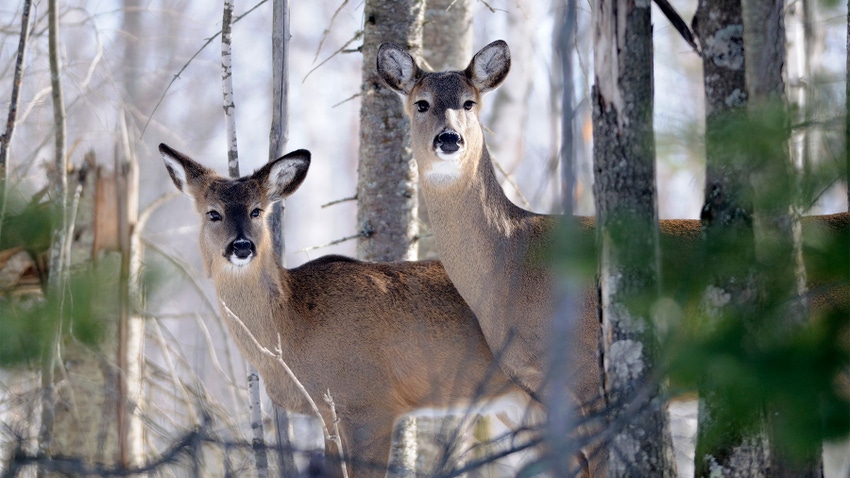November 7, 2023

A 4-year-old doe that was reported to be in poor condition — skinny, drooling and showing no fear of people — in Klacking Township, Ogemaw County, recently tested positive for chronic wasting disease.
It is the first CWD-positive wild deer from that county, a finding confirmed by the University of Wisconsin Veterinary Diagnostic Laboratory in Madison, which works with the Michigan Department of Natural Resources to identify CWD in Michigan’s wild herd.
CWD is a fatal neurological disease that affects white-tailed deer, elk and moose. To date, the disease also has been detected in the following Michigan counties: Clinton, Dickinson, Eaton, Gratiot, Hillsdale, Ingham, Ionia, Isabella, Jackson, Kent, Midland and Montcalm.
“When we find chronic wasting disease in a brand-new location, where previous intensive surveillance has not yet been done, it becomes extremely important for wildlife disease managers to understand where additional cases might be within that county,” says Chad Stewart, DNR deer and elk specialist. “In light of this new detection, we are offering additional opportunities for those interested in getting their deer tested for CWD in Ogemaw County.”
A drop box for CWD testing is available at the Rifle River Recreation Area headquarters, 2550 Rose City Road in Lupton, Mich. The check station typically operated at the DNR field office at 410 Fairview Road in West Branch will be open from 10 a.m. to 3 p.m. Nov. 15-30. The field office will be closed Nov. 23-24 for Thanksgiving.
Self-service test kits, typically available in other locations where CWD has been identified, will not be available in Ogemaw County because of concerns of bovine tuberculosis disease transmission in the county.
Stewart said that CWD is not common among deer in Michigan, and the hunting community can continue to play a key role in assisting the department in disease-testing efforts.
“The DNR sets surveillance goals — basically, a number of deer tested in a particular area — to understand the scale of infection in the local deer herd,” he says. “The closer we come to meeting these goals, the more data we have to identify where and to what extent chronic wasting disease exists in Michigan. Strong hunter participation in testing is critical to that learning, especially in areas where we haven’t yet met surveillance goals.”
Testing background, strategy
In addition to testing around areas of known CWD positives, the DNR in 2021 began a rotational approach to testing around the state. A group of counties is selected each year, with the eventual aim of testing enough deer in every Michigan county.
The goal of this approach is early disease detection, as management has the potential to be most effective when the disease is caught early. Most of these areas have not had a CWD detection or have not previously been part of intensive testing efforts, so little is known about disease status or pathways in these locations.
In 2021 and 2022, the rotational approach focused testing in areas of both the southwestern and southeastern Lower Peninsula.
This year, testing will focus on the northwestern Lower Peninsula and a few counties in other areas where additional herd information is still needed. The focal counties for 2023 CWD testing include Antrim, Benzie, Charlevoix, Emmet, Grand Traverse, Hillsdale, Isabella, Kalkaska, Lake, Leelanau, Manistee, Missaukee, Osceola and Wexford.
These counties will have CWD-testing drop boxes, staffed submission sites, and partner processors and taxidermists to assist with collection efforts.
In the rest of the state, testing is available through direct submission by hunters to a cooperating USDA-approved diagnostic laboratory for a fee or through free self-sample shipping kits in counties where CWD has previously been detected.
Since CWD was first detected in 2015, more than 103,000 deer have been tested for CWD in Michigan. The Ogemaw County deer is the department’s 251st positive animal.
To date, there have been no reported cases of CWD infection in people. However, as a precaution, the U.S. Centers for Disease Control and Prevention recommends infected animals not be consumed as food by either humans or domestic animals.
Hunters also are reminded to use caution when field-dressing or processing a deer. This includes practices such as wearing rubber gloves, minimizing contact with the deer’s brain and spinal tissue, and washing your hands with soap and warm water after handling any parts of the carcass.
Proper disposal of a deer carcass is critical to prevent the spread of chronic wasting disease. Deer carcasses should go directly to a landfill or be disposed of through your regular trash pickup to be taken to a landfill. Deer harvested from known CWD areas should never be disposed of on the landscape in non-CWD areas.
For more information on chronic wasting disease, visit michigan.gov/cwd.
Source: MNDR
Read more about:
DeerYou May Also Like




